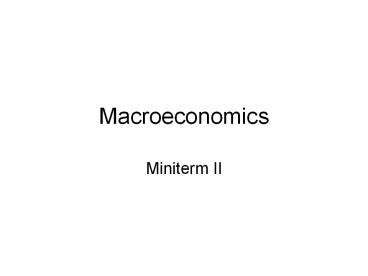Macroeconomics - PowerPoint PPT Presentation
1 / 9
Title:
Macroeconomics
Description:
Macroeconomics Miniterm II Macroeconomics of the short term fluctuations Part I Money and Inflation Part II Empirical facts about short term fluctuations Part III ... – PowerPoint PPT presentation
Number of Views:108
Avg rating:3.0/5.0
Title: Macroeconomics
1
Macroeconomics
- Miniterm II
2
Macroeconomics of the short term fluctuations
- Part I Money and Inflation
- Part II Empirical facts about short term
fluctuations - Part III Keynesian theories of the business
cycles IS-LM model - Part IV Neoclassical theories of the business
cycles, Real Business Cycles models, New
Keynesian macro
3
Short history of macroMankiw (2006) The
Macroeconomist as Scientist and Engineer, NBER
Working Paper No. 12349
- Very few economists studied macroeconomic
fluctuations before 1930s - D. Hume (1752) wrote on monetary policy
- A. Pigou (1927) studied business cycles
- The Great Depression inspired economists to study
aggregate economic variables to explain - Drop in output 31
- Unemployment 25
- Term Macroeconomics first mentioned in 1940s
in works of F. Modigliani, P. Samuelson, R.
Solow, J. Tobin
4
Keynesian approach
- Market are not always in equilibrium, prices are
slow to adjust, consumers are myopic - Main steps of development
- Formulated by Keynes in The General Theory
- Formally modeled by Hicks (1937), Modigliani
(1944) aka IS-LM model - Various computational models based on the IS-LM
model were widely used in 1960s
5
Components of IS-LM model
- IS curve relates financial conditions and fiscal
policies to GDP - LM curve determines interest rates that
equilibrate demand for money - Phillips curve describes how price levels respond
6
New Classical
- Economic agents are rational and markets are
always in equilibrium. Cycles are due to
uncertainty, economic shocks, and bad government
policies - Main advancements of neoclassical approach
- Monetarism, Friedman (1957)
- Rational expectations, Lucas (1973, 1976)
- Real business cycles, Kydland and Prescott (1982)
Long and Plosser (1983)
7
New Keynesian
- Focus on price and wage rigidities, models are
derived from microeconomic principles - Main works
- Systematic monetary policy has real impact Fisher
(1977) - Model of inflation dynamics, Taylor (1980)
8
Who won?
- Empirical evidence shows that
- Prices are slow to adjust
- Real Business Cycles theories can not explain
many of observed regularities - But neoclassical models have more appeal from the
theoretical point - Based on microeconomic principles
- Rational expectations
- Next step new models based on utility
maximization of economic agents, but introduce
market imperfections.
9
Outline of the course
- We will spend 3 lectures studying money and
inflation - Then we discuss some empirical facts about the
business cycles (1 lecture) - Then we move to the closed economy IS-LM model
and discuss Keynesian view on aggregate demand.
(3-4 lectures) - Then we discuss theories that model aggregate
supply (2 lectures) - Finally we will talk about the real business
cycle theory and new Keynesian economics. (3-4
lectures)

